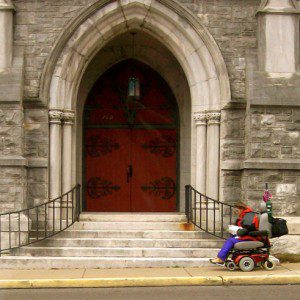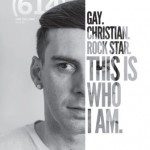
A few months ago I was invited to preach at a fairly large church in New Jersey. Two of the church’s worship services overlapped—a contemporary service and a traditional one—so I had to leave one service early, right after my sermon, to come in half-way through the other service, just in time to preach again. This meant that my first time entering the worship space was after the church service was already well underway and with only minutes before it was time to preach.
Normally I like to stop and reflect in a worship space that’s new to me. Normally I like to imagine what the art, the symbols, the lighting, even the architecture might say about God, about the congregation and its relationships, and about God’s relationship to the congregation. On this occasion, with such little time between my entrance into the service and my sermon, the only aspect of the church that I really had time to take in were the stairs that spiraled into its pulpit. I had just enough time to think to myself, “good thing I don’t use a wheelchair.” What this mundane little stairway said to me on that day was, “the church is for the able.” Then I climbed the stairs and preached my sermon.
But in that little moment of orienting myself to the worship space, I was reminded of a conversation I’d had only a day or so before with a friend. He explained that he was pursuing ordination but was running into all kinds of problems from the church because he is in a wheelchair. I am reminded now of other friends I’ve known who have been called to ministry but have had troubles because of disability.
These problems are not just in the architecture. They’re in our hymnals, they’re in our art, they’re in every hanging picture of a muscle-bound messiah, they’re even in our prayers. Human limitations of all kinds become disabilities whenever we say, implicitly or explicitly, “the church is for the able.” Whenever we choose to accommodate one human limitation over another, we create disability and we disable the church from its ministry.
The church was never meant to be for the “able.” The church, and the gospel itself, has always been for the “weary and heavy-laden” (Matthew 11:28). The implications of this for the church’s ministry to young people is huge… not only because of the ubiquity of disability among young people (according to Ben Conner, “eighteen to twenty percent of the population has a disability and thirteen percent of US children and youth in public schools receive special education…”), but also because of all the implicit ways the young are “disabled” in the church and society. The signs won’t always be as obvious as a stairway into a pulpit, but just as the church says that it’s really for the “able” it also has ways of saying that it’s only for the mature. We have ways of disabling young people by virtue of their youth and the limitations associated therewith. But if the church is really for the weary and the heavy-laden, and if the church is in pursuit of “childlike faith,” then we need to find new and corresponding ways of saying, “you are accepted, all are welcome.”
One of the best places to start is to stop seeing disability as a “problem” to be solved or “cured” and to start seeing it as a human experience to be understood… and, as such, something that promises to reveal God to us and heal us. Disability may help teach us that all human life is marked my limitation, by inability and even impossibility. The church is not about the ability of its members, but the possibility of God in the midst of our inability. Youth ministry is not about the possibility of youth but about the saving and liberating action of Christ in the face of our sin and our death.
There’s a really important conversation happening at the Princeton Institute for Youth Ministry in their Youth Ministry and Disability blog series. I believe it sheds some light in this direction. If you’re interested in reflecting further on the “promise of disability” for youth ministry, I’d encourage you to check out the series.












